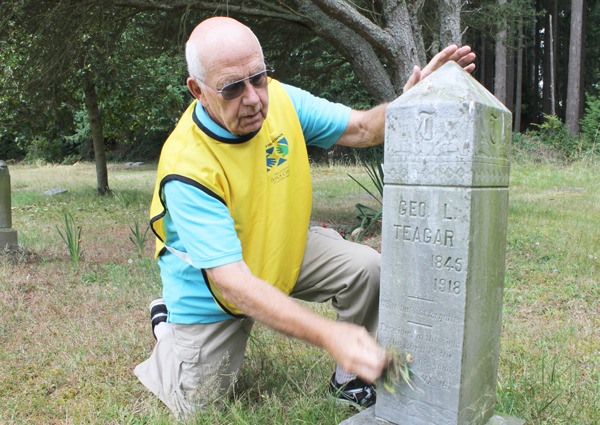Worn and weathered grave stones sit amidst the dandelions in Bayview Cemetery, some covered in moss, others overrun with errant foliage, several sinking visibly into the soft dirt beneath, eroded by decades of rain.
Since 1905, the cemetery has provided a final resting place for individuals young and old. Along with flowers and American flags, some spaces are decorated with items denoting the personality of the inhabitants—toy cars, photos, personalized wreaths, an empty bottle of a favorite beverage.
For those interred within its grounds and their respective loved ones, a group of community volunteers has taken on the task of cleaning and restoring the cemetery for the past three years.
The Church of Jesus Christ of Latter-day Saints on South Whidbey will once again host its annual day of service and remembrance Saturday from 9 a.m. to noon.
During these volunteer gatherings, members of the church join with fellow area residents to pressure wash stones, remove weeds and debris, trim the grass and right sinking stones.
Frank Thornton, who has been in charge of the clean-up for the past three years, explained that in 2002, President Bush’s declaration of Sept. 11 as a national day of service and remembrance prompted LDS congregations in the Puget Sound area to adopt the concept in 2009, calling the occasion a National Day of Service.
He said the South Whidbey Church of Jesus Christ of Latter-day Saints ward decided to focus on the Bayview Cemetery in part due to its proximity to the ward — a small, geographically-defined congregation — on Maxwelton Road as well as because of the 30-40 ward members whose loved ones are interred at the cemetery.
For the family members of those interred at Bayview Cemetery, the project provides peace of mind, said Thornton.
In years past, the group has focused on restoring the older, west section which contains graves dating back as far as 1902. This year, volunteers will also be working on the east section of the cemetery.
“That [east] part of the cemetery is not nearly as comfortable to look at as this [west] one,” said Thornton. “We figured this year maybe we can try. We may have bitten off a bit more than we can chew, but we’re hoping not. We’re hoping we can get some local people to come out and help us.”
This year, groups from the Deer Lagoon Grange and American Legion Post 141 are expected to lend a hand.
Gesturing to a gravestone wrapped in green moss and algae, Thornton explained that pressure washing is an integral part of the clean-up due to the large amount of build-up on many of the tombstones which render their inscriptions indecipherable.
“That’s one of the biggest levels of effort,” he said. “By us doing that consistently every year, these monuments look a lot better than they did the first year.”
Thornton explained that in perpetual care cemeteries such as those in which his family members are buried, the grounds are consistently kept up by staff. In his opinion, he said, all cemeteries should receive a minimum of an annual “brightening.”
“There is something unique about cemeteries that belong to all of us, whether or not we have people interred here or whether we even have the idea that this is where our body is going to be buried,” said Thornton. “It’s a part of a community that needs to be [well] maintained.”
In addition to cleaning the stones and grounds, volunteers have worked to photograph the grave stones and archive them at findagrave.com. This year, volunteers are working to determine the names of veterans interred in unmarked graves in the hopes of creating engraved markers in memoriam.
Daryl Moss, Thornton’s fellow church member and volunteer, explained that for him and other members of the church, there is an element of duty to honor both ancestors and country.
“We have pride in our history. We have a belief that there are certain ordinances that we still perform for those that have passed on,” said Moss. “We love our country. We love those who have preserved our country. …We are trying to do for the community what we believe our ancestors are deserving of.”
Thornton added that in addition to honoring ancestors, it is also an opportunity to honor life. When the debris and dirt has been cleared from the engraved dates, he said, it becomes clear that the marker denotes the life of a real person. When the name becomes legible, he said, it is easy to envision the person’s life and to feel empathetic.
“You take a few moments and think about that individual and their life and you realize that you have a life that corresponds to what theirs was,” he said. “You realize how much you enjoy living, you know how much you enjoy your family, your loved ones and all of your friends. You realize that there lies the remains of an individual who also had similar feelings and family. That kind of empathy makes you realize that one life is something very special….Everyone is significant in the eyes of our Father in heaven. We are all brothers and sisters.”



